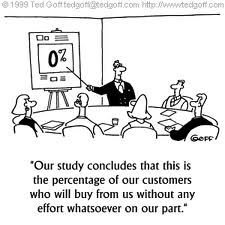 I think everyone will agree that the right kind of training (sales and/ or customer service/ management/ leadership training) can be a great way to enhance your business.
I think everyone will agree that the right kind of training (sales and/ or customer service/ management/ leadership training) can be a great way to enhance your business.
A lot of companies hire an outside sales or customer service training company to deliver just that. Helping their employees to come up with new sales strategies, better customer service options and overall suggestions on how to enhance the business.
The key issues that I found in my research however show that many companies are not happy with their training provider due to lack of support, changes that are not implemented properly and the motivation of the team starts going down after a few days and revert back to their former self. Also in many cases sales and customer service training is kept very generic and is not developed to the need of the client but rather using off the shelf programs.
So, the big question is, who is responsible? Is it the trainer who seems to fail to deliver on his/ her promise or is it the attendees of the training who fail to implement what they’ve learned on a daily basis? Is it the company which doesn’t want to take on board the trainers advise or simply doesn’t want to spend more money on additional training or consultation/ coaching?
The answer might be shocking: It’s a little bit of everything. Let me elaborate:
Lets say you attend a sales training, the trainer gives great examples, clearly defined strategies (or helps you develop a strategy), great new ways of thinking and even adds how to improve on your customer service skills. You spend 2 days at this training and you come out, highly motivated and ready to roll. You go to your boss, tell them all about what you’ve learned in the training and why things are not working for the company (because now you believe you have the solution) but your boss shuts you down. He hasn’t been in the training, so he doesn’t really understand and from the bits that you remember he can’t really make up his mind if this would be a good way to go or not. So, he says, we stick to the old ways. Or maybe you are lucky and he doubts that this will work but will give you a chance to prove him wrong. So, off you go, thinking about what your boss said, and maybe even agree with him after seeing his point of view. Still you want to give it a try and now, with your boss’s point of view in mind you try your best and after one day fail to deliver. 2 days after you find yourself in the same misery as before, training is long forgotten and nothing changed.
Did you ever experience something like that?
Maybe you are the boss and your company sent you to a sales training to come back and deliver this training afterwards to the employees. You come out of the training, you think you know it all and give now your answers to the employees or sales team on how things should be done from now on. You’ve done your job, and now it’s up to the team to take your (crippled) information and make the best out of it. And to your surprise, it doesn’t work. Did you ever experience that?
Or a third scenario, you are the boss, you and your team have been trained by the company, you all agree on the changes that are required in order to make this work but find that after a few days, nothing really changed? You may have meetings about it, how to implement the new changes, you uncover some challenges on the way and suddenly decide that maybe it’s not such a good idea or you are stuck for answers?
Now, here is the reason of why this is happening:
1. You are capable of only remembering approx. 15% – 25% right after the training (this is the moment you step out of the training room and somebody would ask you what do you remember). No matter how good or bad the training is, and how much you keep writing during the training, it will not help you deliver the entire programme to your team or your boss.
2. Within 24 hours after the training your memory will even more deteriorate to approx. 5 – 10%.
3. 5 days after the training your memory will get worse and you remember approx. 1 – 3% of the training.
4. You are not a trainer or coach. Unless you went through extensive training becoming a business coach or sales trainer (and lets face it, barely any managers are) you are not capable of delivering the training to your staff (no matter how good you think you are).
5. Without any follow up coaching in place, no matter how many training sessions you’ve had, you will not be able to make it work.
6. Without the buy in from management about any changes that the training company suggests, you will have no chance of succeeding and make the training work for you.
There you have it. 6 points of why things are not working. In order to make any training work let me summarize in a more positive way what you could do to make this happen:
1. The right consultation is key
Training needs have to be assessed first. It’s important to understand the needs of the company as well as the individual needs of the attendees. (Interviews with management and key personnel (or maybe even all personnel that need to be trained) should be done to understand the training requirements.
2. Get management to buy in first
Buy in from management is crucial and in order to see the point of the sales trainer or consultant it is important that the management understands the changes that are required (if any) for the training to work.
3. Get agreement from management on necessary changes
The company should agree upfront on the changes that are required or needed in order to drive more sales or customer service and be happy with them. No matter how good a sales trainer you hire (or if you are a trainer then it doesn’t even matter how good you are), the trainer can only deliver on the information you provide and the changes that you are willing to take. If you don’t want to take certain risks, then the trainer need to know this information before hand in order not to make any suggestions on how to sell or improve your services.
4. The training should be created around the key areas and changes.
Training can only be successful if it is created with the companies needs in mind.
5. Training should be delivered to management first and staff second
It is important to deliver first to the management (if possible entire management) to make sure all points that have been agreed on are covered, to see if anything is missing and to get the entire management behind the concept. Afterwards training needs to be delivered to the remaining staff/ employees.
6. Follow up coaching to help implement the changes and discuss any challenges that the team might face over the coming weeks
Follow up coaching is probably the most important aspect of the training. It empowers the team and managers to find the best solutions on how to implement the changes and will provide the success that is needed in order to get the team to the next level.
So, how can this boost your companies image? Imagine you’ve had a training, a great training and you had somebody help you implement what you’ve learned during the training on a regular basis? That will give you the focus that you need and helps you drive sales and customer service levels. Your sales team will not be required to make any drastic changes right away but will continue to improve over a certain period of time until peak levels are achieved. Your company’s image will now rise to become the best in their field and the reason? Because you understand the training needs of your employees and now you can find the right training and coaching company to help you achieve greater results that you could have hoped for.
One thing I would like to add is that remember how long it took you to learn anything in school? No matter what the subject, but to get a complete understanding it took you years of learning and practice. So, why do we think that sending our staff to a one off sales or customer service training will do the trick? Let me assure you, it won’t. In order to implement what they’ve learned during the training course, follow up coaching needs to be provided. Only then will you see the results. It takes approx. 28 days to change a habit. If your sales people have bad habits, then the training might be a way in to create a new more positive habit, but only by doing the things that need to be done on a daily basis can your team start to excel. This can only be done with coaching the person (or group) on the required changes. And isn’t that why you spend the money on the training in the first place?
What is your experience with training companies? Or maybe you are a trainer and would like to share your opinion? I would love to hear your opinions on the subject.
Thank you for reading.
Follow us on Facebook and Twitter for more up to date information.
Carsten
Carsten Schnier is the founder of SalesClinic & Coach Clinic and professional sales consultant based in Cork, Ireland. Creating a synergy between consultation, training and coaching helps our clients to achieve the best results.
 We all do it. Every day thousands of people do their grocery shopping, spending lots of money in 1 or more stores and super markets.
We all do it. Every day thousands of people do their grocery shopping, spending lots of money in 1 or more stores and super markets.








